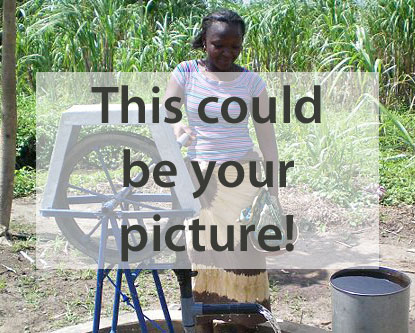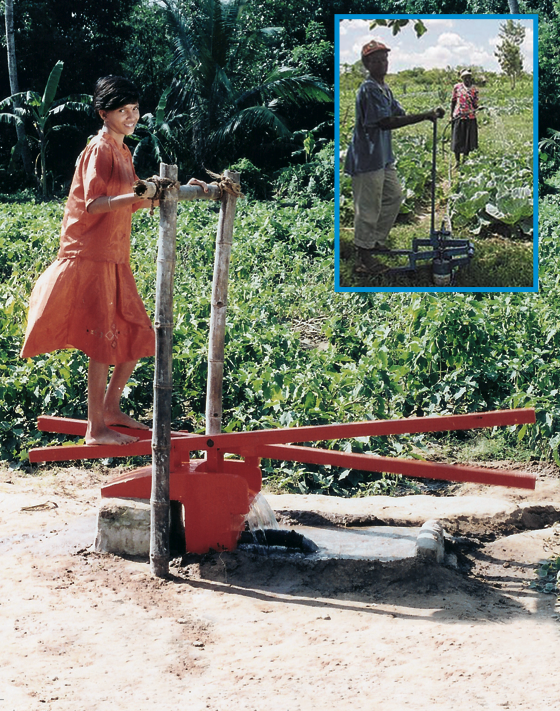Difference between revisions of "Treadle pump"
| Line 1: | Line 1: | ||
| − | |||
[[Image:Treadle_pump_icon.png|right]] | [[Image:Treadle_pump_icon.png|right]] | ||
[[Image:Treadle_pump.PNG|thumb|right|150px| The bamboo version of the treadle pump used in Bangladesh ]] | [[Image:Treadle_pump.PNG|thumb|right|150px| The bamboo version of the treadle pump used in Bangladesh ]] | ||
__NOTOC__ | __NOTOC__ | ||
| + | |||
| + | The treadle pump is a foot-powered water pump widely used in Asia and spreading in Africa. It consists of two metal cylinders with pistons that are operated by a natural walking motion on two treadles. As the cylinders of the treadle pump are above the ground, the maximum depth from which water can be drawn is about 7m. | ||
| + | |||
| + | There are several variations of the treadle pump: | ||
| + | * The River Pump: is mounted on a portable metal stand so that it can be easily moved from one water source to another. It is used to pump from surface water sources. It requires an inlet hose for suction. A borehole is not required. | ||
| + | * The Metal Treadle Pump: incorporates permanently attached metal treadles, which increases portability. It can be mounted on a borehole (like the basic Treadle Pump) to draw from groundwater sources. It can be mounted on a metal frame (like the River Pump) to draw from surface water sources. | ||
| + | * The Concrete Pump: has PVC cylinders embedded in a concrete body. This prevents corrosion of the device in regions with saline groundwater. It is mounted on a borehole to draw from groundwater. | ||
| + | * Plastic Pump: Using only plastic in the construction prevents corrosion in regions with saline groundwater. It can also be mounted on a borehole to draw from groundwater. | ||
==History and social context== | ==History and social context== | ||
| − | |||
| − | The treadle pump is cost effective | + | The treadle pump was designed by the Norwegian engineer, Gunnar Barnes in the 1970’s. It was first developed and used for irrigation in Bangladesh in the late 1970’s. |
| + | |||
| + | In the 1980s, International Development Enterprise (IDE) initiated a campaign to market the pumps to smallholder farmers. Over the course of 12 years, 1.5 million treadle pumps were purchased by farmers, increasing the farmers income by $150 million annually. The cost of the treadle pump scheme was $12 million, compared with conventional dam and canal systems, which would have cost $1.5 billion to irrigate a similar area. The treadle pump programme in India won an Ashden Award in 2006. | ||
| + | |||
| + | The treadle pump is very cost-effective. Its low cost makes it accessible to even very poor farmers who can use it to grow dry-season vegetables for home consumption and for sale. In Bangladesh, a pump costs US$ 20. On average, farmers are able to generate more than US$100 per year in extra income. Income from treadle pumps adds US$100 million to the GNP of Bangladesh annually. Production and sales are sustainable now without external aid. | ||
| + | With this technology, many families have increased their income. Some farmers who started with this pedal pump have now bought a motorized pump. | ||
The treadle pump is also being promoted in Africa where it is installed by organisations like Kickstart (former Approtec) and EW Enterprise Works. Models of the treadle pump like the Moneymaker and the Soka-pump are now widely used for small-scale "spray" irrigation. | The treadle pump is also being promoted in Africa where it is installed by organisations like Kickstart (former Approtec) and EW Enterprise Works. Models of the treadle pump like the Moneymaker and the Soka-pump are now widely used for small-scale "spray" irrigation. | ||
| + | Currently, over 2 million treadle pumps have been installed worldwide. Up to 1.3 million treadle pumps are in use Asia, and some 35,000 in Eastern Africa. They are being produced in 300 local workshops worldwide and used by more than one million poor rural families that otherwise could not have afforded an irrigation pump. | ||
| − | |||
==Suitable conditions == | ==Suitable conditions == | ||
Revision as of 12:26, 6 August 2009
The treadle pump is a foot-powered water pump widely used in Asia and spreading in Africa. It consists of two metal cylinders with pistons that are operated by a natural walking motion on two treadles. As the cylinders of the treadle pump are above the ground, the maximum depth from which water can be drawn is about 7m.
There are several variations of the treadle pump:
- The River Pump: is mounted on a portable metal stand so that it can be easily moved from one water source to another. It is used to pump from surface water sources. It requires an inlet hose for suction. A borehole is not required.
- The Metal Treadle Pump: incorporates permanently attached metal treadles, which increases portability. It can be mounted on a borehole (like the basic Treadle Pump) to draw from groundwater sources. It can be mounted on a metal frame (like the River Pump) to draw from surface water sources.
- The Concrete Pump: has PVC cylinders embedded in a concrete body. This prevents corrosion of the device in regions with saline groundwater. It is mounted on a borehole to draw from groundwater.
- Plastic Pump: Using only plastic in the construction prevents corrosion in regions with saline groundwater. It can also be mounted on a borehole to draw from groundwater.
History and social context
The treadle pump was designed by the Norwegian engineer, Gunnar Barnes in the 1970’s. It was first developed and used for irrigation in Bangladesh in the late 1970’s.
In the 1980s, International Development Enterprise (IDE) initiated a campaign to market the pumps to smallholder farmers. Over the course of 12 years, 1.5 million treadle pumps were purchased by farmers, increasing the farmers income by $150 million annually. The cost of the treadle pump scheme was $12 million, compared with conventional dam and canal systems, which would have cost $1.5 billion to irrigate a similar area. The treadle pump programme in India won an Ashden Award in 2006.
The treadle pump is very cost-effective. Its low cost makes it accessible to even very poor farmers who can use it to grow dry-season vegetables for home consumption and for sale. In Bangladesh, a pump costs US$ 20. On average, farmers are able to generate more than US$100 per year in extra income. Income from treadle pumps adds US$100 million to the GNP of Bangladesh annually. Production and sales are sustainable now without external aid. With this technology, many families have increased their income. Some farmers who started with this pedal pump have now bought a motorized pump.
The treadle pump is also being promoted in Africa where it is installed by organisations like Kickstart (former Approtec) and EW Enterprise Works. Models of the treadle pump like the Moneymaker and the Soka-pump are now widely used for small-scale "spray" irrigation. Currently, over 2 million treadle pumps have been installed worldwide. Up to 1.3 million treadle pumps are in use Asia, and some 35,000 in Eastern Africa. They are being produced in 300 local workshops worldwide and used by more than one million poor rural families that otherwise could not have afforded an irrigation pump.
Suitable conditions
The treadle pump can be used on small farms which draw irrigation water from 1-7 m deep. A treadle pump can pump around 100 litres / min from 4 meters depth.
Because a treadle pump is a suction pump, the depth from which water can be drawn is limited to 7m.
| Advantages | Disadvantages/limitations |
|---|---|
| - Simple and cheap - Produced in local workshops. |
- Pumping depth limited to 7m. |
Technical specification
Operation
Maintenance
Manufacturing
Cost
- A treadle pump costs US$ 20 in Bangladesh, and US$ 50-80 in Africa.
- The cost of introduction lies around US$ 20,000 per project, including training, engineering and first production.
Country experiences
The Treadle Pump is widely used in Asia, and increasingly used in Africa.
Manuals
Movies
- Treadle pumps in Uttar Pradesh, India, introduced by IDE-India. Movie produced by Ashden Awards.
External links
- International Development Enterprises (IDE)
- MoneyMaker treadle pump produced by Kickstart (Kenya, Tanzania)
- Pedal Pump, produced by Enterprise Works
- Treadle Pump programmeIDE-India
- "Our life is much better" - a case study from Zambia, by IDE
- Ashden Award article on Treadle Pumps by IDE-India
References

|

